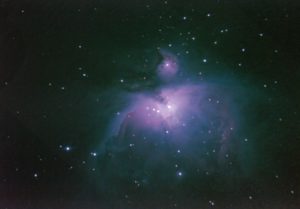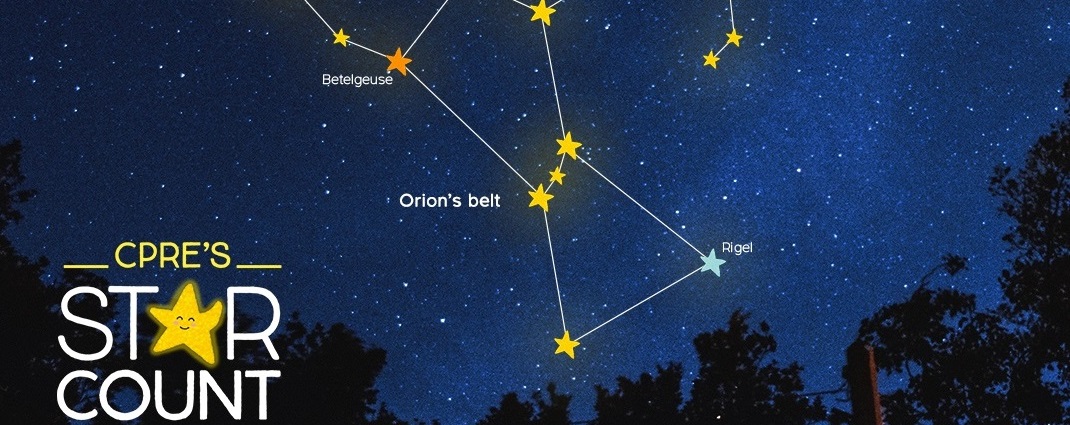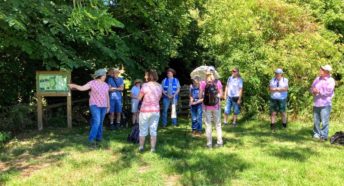Star Count and Northumberland’s Dark Skies
CPRE’s Star Count 2022 takes place from 26 February to 6 March this year.
This annual event serves many worthwhile purposes and is justly popular with members of CPRE and the general public.
Its main function is to get people to look up into the night sky at the constellation of Orion and count the stars within a rectangle formed by the four prominent stars Betelgeuse, Bellatrix, Rigel and Saiph.
Roughly mid way between them lies the easily recognisable ‘Orion’s belt’ with its three stars in line and the ‘dagger’ slung beneath them. You might be able to see a faint glow behind the middle star in the ‘dagger’. This is the Orion nebula, a favourite object of study by amateur astronomers.
The number of stars visible to each observer gives an indication of how good that location is for viewing the night sky. Many urban areas are badly affected these days by the ‘sky-glow’ of stray light from poorly-shaded street lamps, urban traffic, advertising hoardings and illuminated shop-fronts. The south eastern part of Northumberland cannot escape the Tyneside sky-glow effect. On the other hand, the north western quarter of the county has the darkest skies in England.
The thousands of respondents who send their results to CPRE help us to monitor the quality of all of England’s skies. Predictably, the skies over the largest conurbations – where of course the majority of people live – are the worst, though rural areas away from cities can still offer the people who live there breathtaking views of the sparkling heavens on clear winter nights, a life-enhancing experience for the human race for thousands of years.
This image taken of the Milky Way, as seen from near Dunstanburgh Castle on the Northumberland coast, captures that feeling of awe and wonder perfectly.

If your area has reasonably dark skies, you should be able to see something like this when you look at Orion.

But Star Count can provide far more than this check on the wide-spread light pollution of our country. It helps, for instance, to foster the ‘citizen science’ habit by involving large numbers of people in a controlled survey with published results.
Even more important is the opportunity it provides to teach children of all ages something about the stars we can all see in the night sky. Their role in the development of every human culture has been immense, and the names we still use today reflect this.
People have been looking at the stars for many thousands of years, and making up stories about what they think they represent. Astronomy – the study of the stars – was developed by the Greeks about two and a half thousand years ago, with Ptolemy, the Egyptian scholar based in Alexandria, the most influential. Orion still carries the name it was given by the Greeks based on a legendary hunter. The Pleiades and Cassiopeia are two other Greek-named constellations.
Then the Romans made their contribution to the study of the heavens, and many names we now use are Latin terms, Ursa major, for instance, Taurus and Pegasus. Most children will also know at least some of the seven planets which accompany the Earth in orbiting our sun. Jupiter, Mars, Venus and Saturn, which all carry the names of Roman deities, can be seen with the naked eye at certain times of the year, and are worth looking out for.
Many star names, meanwhile, reflect the work of Arabic scholars who carried the torch of astronomical study through the Middle Ages. In Orion, for instance the star names Betelgeuse, Bellatrix, Rigel and Saiph are all Arabic in origin, as are the three stars of Orion’s belt, Alnitak, Alnilam and Mintaka.

The use of even a small telescope on a mount can bring stars and planets and the craters of the moon within reach of anyone, and some will want to go on to join a local astronomical society, with telescopes large enough for serious study.
This stunning image, taken through a telescope, of the Orion nebula (M42), revealing its delicate filaments of illuminated gas, was taken recently in Alnwick by Ian Forster, a member of the Northumberland Astronomical Society. It shows what can be achieved with skill and the help of modern photographic processing, but also says something about the skies, even in a town, over the heart of Northumberland.










